65-144 Million Years Ago
Highlights of the Cretaceous Period
- The period ended with a mass extinction event where approximately 50% of all genera became extinct, including all of the non-avian dinosaurs. The most wildly accepted theory for the cause of this extinction was a meteor which hit in the Yucatan peninsula and sent a cloud of particles into the atmosphere, blocking out the sun. This caused a dramatic change in the world's climate and killed off a large amount of the world's plant life. Do to this plant shortage the largest of the plant eater most likely starved causing a shift to the small bird like dinosaurs
- The majority of well known Dinosaurs come from this period. Many that were made popular from 1993 film Jurassic Park, such as the Tyrannosaurus Rex, Velociraptor, Triceratops, Brachiosaurus and Parasaurolophus were all from the Cretaceous
Dinosaurs are a group of now extinct reptiles who roamed the planet during the Mesozoic era. They first appeared approximately 251 million years ago and went extinct 65.6 million years ago.
Cretaceous Dinosaurs (Click to jump to Dinosaur)
- Tyrannosaurus Rex, “King of the Tyrant Lizards”
- Parasaurolophus, “Similar Crested Lizard”
- Deinonychus, “Terrible Claw”
- Albertosaurus “Alberta Lizard”
- Velociraptor “Quick Hunter”
- Troodon “Wounding tooth”
- Lambeosaurus “Lambe’s Lizard”
These are the fossils of the Cretaceous period that we have in our collection. Remember these are not representative of the total of Cretaceous creatures.
See our Dinosaur bits and pieces image gallery!
Tyrannosaurus Rex, “King of the Tyrant Lizards”
-
Order: Saurischia, lizard-hipped dinosaurs
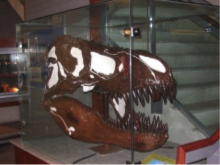
- Length: 12 to 15 metres
- Weight: 6.35 tonnes
- When did I live? Late Cretaceous period, 65 million years ago
- Where? Western North America
- What family did I belong to? Carnosaur Tyrannosaurids
- What food did I eat? I preyed on large plant eating dinosaurs such as duckbills, ankylosaurus and triceratops
- What special feature did I have? My size; I was the largest member of my family at 5 meters tall
Parasaurolophus, “Similar Crested Lizard”
-
Order: Ornithischia, bird-hipped dinosaurs
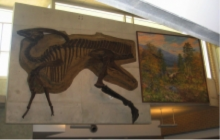
- Length: 9 metres
- Weight: 3.26 tonnes
- When did I live? Early Cretaceous Period, 75 million years ago
- Where? North America
- What family did I belong to? Hadrosauridae, which means “duckbill”
- What food did I eat? Vegetarian
- What special feature did I have? My unusual long crest that curved backwards from my head helped me breathe and smell
- This specimen was discovered at Little Sandhill Creek, Alberta. The skeleton displayed here is a cast; the original is on display at the Royal Ontario Museum, Toronto
Deinonychus, “Terrible Claw”
-
Order: Saurichia, lizard-hipped dinosaurs
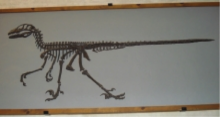
- Length: 3-4 metres
- Weight: 70 kg
- When did I live? Early Cretaceous Period, 140 million years ago
- Where? Western North America
- What family did I belong to? Theropoda, Dromaesaurids
- What food did I eat? I ate plant-eating dinosaurs such as titanosaurs and ankylosaurs
-
What special feature did I have? The large curved claw on the second toe of my foot. When I ran the claw was flicked back to place the shorter toes on the ground. I balanced on one foot in order to swing the claw at the belly of another dinosaur. The foot of Deinonychus is one of the most extraordinary of any dinosaur. It has four toes. The first toe is a small spur (1) and very much like the first toe on most theropods. The second toe (2) is the most striking feature of the foot, with its enormous claw.
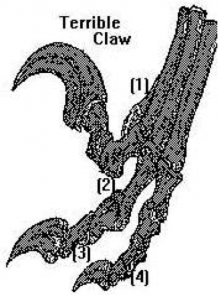
- The joints of this tow are specially enlarged so that the toe can be raised upward and backward to avoid damage while running. The other two toes (3 and 4) are of roughly equal length and were the ones used for running on. The toes could be flexed through a very wide arc in order to penetrate the flesh of its prey
Albertosaurus “Alberta Lizard”
-
Order: Saurichia, lizard-hipped dinosaurs
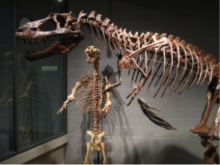
- Length: 35 feet
- Weight: more than 2 tonnes
- When did I live? Late Cretaceous, 70 million years ago
- Where? North western America
- What family did I belong to? Theropoda, Tyrannosauridae
- What food did I eat? I ate plant-eating dinosaurs. I swallowed my food in large chunks without chewing it
- What special feature did I have? Albertosaurus skeletons have been found lying together in Canada. This suggests that this animal lived in herds.
Velociraptor “Quick Hunter”
-
Order: Saurichia, lizard-hipped dinosaurs
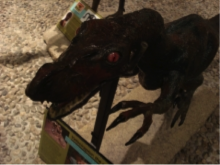
- Length: 5.50 feet
- Weight: 30kg
- When did I live? Late Cretaceous, 80 million years ago
- Where? Mongolia, Asia, China
- What family did I belong to? Theropodia, dromaeosauridae
- What food did I eat? Small animals
- What special feature did I have? The velociraptor’s tail was made of hard fused bones, that made it very inflexible. This means that although the tail cannot be used as a weapon, it can keep the animal balanced as it hunted, ran and jumped.
Troodon “Wounding tooth”
-
Order: Saurichia, lizard-hipped dinosaurs
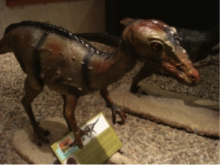
- Length: 6.6 feet
- Weight: 50 kg
- When did I live? Late Cretaceous 76-70 million years ago
- Where? North America
- What family did I belong to? Troodon formosus
- What food did I eat? Small animals
- What special feature did I have? A Troodon had the largest brain in proportion to its body weight. It may have been the smartest dinosaur (as smart as a modern bird).
Lambeosaurus “Lambe’s Lizard”
-
Order: Ornithopoda, bird-hipped dinosaurs
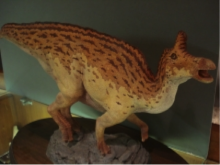
- Length: 50 feet
- Weight: 6000 kg
- When did I live? Late Cretaceous, 70 million years ago
- Where? Alberta, Mexico, North America
- What family did I belong to? Hadrosauridae, Lambeosaurinae
- What food did I eat? I ate plants
- What special feature did I have? Lambeosaurus had a high, domed head with a large hatchet-shaped crest containing hollow nasal air passages. There is also ample evidence that some hadrosauruswere social animals; they may have travelled in large herds.Hatchlings lacked crests, but developed them as the skull grew until it reached its adult form.